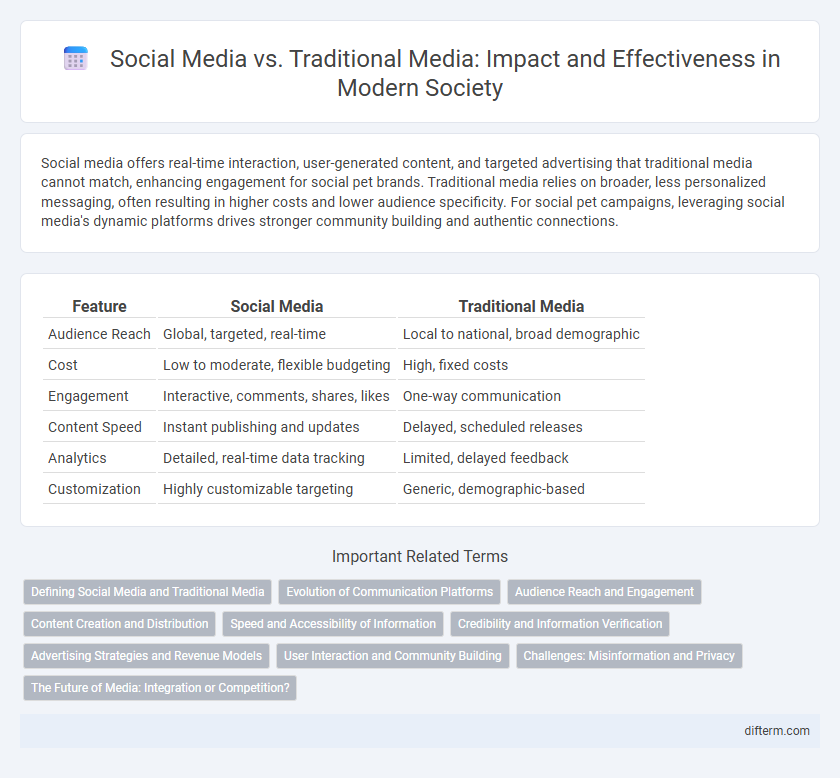Social media offers real-time interaction, user-generated content, and targeted advertising that traditional media cannot match, enhancing engagement for social pet brands. Traditional media relies on broader, less personalized messaging, often resulting in higher costs and lower audience specificity. For social pet campaigns, leveraging social media's dynamic platforms drives stronger community building and authentic connections.
Table of Comparison
| Feature | Social Media | Traditional Media |
|---|---|---|
| Audience Reach | Global, targeted, real-time | Local to national, broad demographic |
| Cost | Low to moderate, flexible budgeting | High, fixed costs |
| Engagement | Interactive, comments, shares, likes | One-way communication |
| Content Speed | Instant publishing and updates | Delayed, scheduled releases |
| Analytics | Detailed, real-time data tracking | Limited, delayed feedback |
| Customization | Highly customizable targeting | Generic, demographic-based |
Defining Social Media and Traditional Media
Social media refers to digital platforms like Facebook, Twitter, and Instagram that enable user-generated content, real-time interactions, and personalized communication. Traditional media includes newspapers, television, and radio, characterized by one-way, mass communication with limited audience interaction. The key distinction lies in social media's ability to facilitate two-way conversations and viral content sharing versus traditional media's structured, scheduled broadcasts.
Evolution of Communication Platforms
Social media revolutionized communication platforms by enabling instant, two-way interaction and personalized content sharing, contrasting with traditional media's one-way broadcast model. Platforms like Facebook, Twitter, and Instagram utilize algorithms to tailor content to user preferences, increasing engagement and real-time connectivity. This evolution shifted audience roles from passive consumers to active contributors, transforming social dynamics and information dissemination globally.
Audience Reach and Engagement
Social media platforms offer unparalleled audience reach through targeted algorithms and real-time content sharing, enabling brands to engage millions globally with personalized messages. Traditional media, while limited by geographic and temporal constraints, maintains a broad but passive audience that consumes scheduled programming or print without direct interaction. The interactive nature of social media drives higher engagement rates measured by likes, comments, and shares, contrasting with traditional media's primarily one-way communication model.
Content Creation and Distribution
Social media platforms enable real-time content creation and direct distribution to targeted audiences, significantly increasing engagement and personalization compared to traditional media. Unlike traditional media's one-way broadcast model, social media leverages user-generated content and viral sharing mechanisms to amplify reach rapidly. Data analytics tools integrated into social platforms provide detailed insights into audience behavior, allowing creators to optimize content strategy dynamically.
Speed and Accessibility of Information
Social media enables instantaneous sharing and consumption of information, surpassing traditional media's slower publication schedules and limited broadcast reach. Platforms like Twitter and Facebook deliver real-time updates accessible globally on multiple devices, facilitating rapid response and interaction. Traditional media often relies on scheduled programming and print deadlines, restricting immediate access and user engagement with breaking news.
Credibility and Information Verification
Social media platforms often face challenges with credibility due to the rapid spread of unverified information and user-generated content lacking editorial oversight. Traditional media, with established journalistic standards and fact-checking processes, generally provides more reliable and verified information. However, the dynamic nature of social media enables faster information dissemination, making real-time verification tools increasingly essential for ensuring accuracy.
Advertising Strategies and Revenue Models
Social media advertising leverages targeted algorithms and real-time data analytics to deliver personalized ads, driving higher engagement and conversion rates compared to traditional media's broad audience approach. Revenue models in social media primarily rely on pay-per-click, sponsored content, and influencer partnerships, whereas traditional media depends on fixed-rate commercial slots, print ads, and subscription fees. Enhanced user interaction on social platforms allows advertisers to optimize campaigns dynamically, maximizing ROI and market reach beyond conventional broadcast and print methods.
User Interaction and Community Building
Social media platforms enable dynamic user interaction through real-time comments, sharing, and direct messaging, fostering immediate engagement unlike traditional media's one-way communication. Communities on social media grow organically as users create groups, events, and shared content, enhancing connectivity and collaborative discussions. User-generated content and influencer participation further amplify community building by creating authentic and relatable online experiences.
Challenges: Misinformation and Privacy
Social media platforms amplify challenges of misinformation through rapid content sharing without thorough fact-checking, contrasting with traditional media's editorial oversight. Privacy concerns escalate as social media collects vast amounts of user data, often without transparent consent, while traditional media operates under stricter regulatory frameworks. The dynamic and user-driven nature of social media complicates regulation, making misinformation and privacy protection critical issues for digital communication.
The Future of Media: Integration or Competition?
Social media platforms leverage real-time engagement and user-generated content, reshaping how audiences consume information and interact with brands. Traditional media, with its established credibility and structured programming, continues to hold significant influence, especially among older demographics. The future of media likely involves a hybrid model where integration enhances content delivery and audience reach rather than pure competition.
social media vs traditional media Infographic

 difterm.com
difterm.com